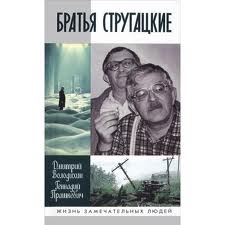Guest post by Kevin Reese
This is a “halfway mark” review of the recently published biography of the Strugatskii brothers by Dmitrii Volodikhin and Gennadii Prashkevich, part of the long-standing Zhizn’ zamechatel’nykh liudei series. I purchased the book in December, but the publication date reads 2012. For a few weeks, then, I was literally reading a book from the future. 
I was about halfway done with the book when the semester started, and teaching obligations have prevented me from getting back to reading it properly. This being said, I think that I have processed more than enough of the book to get a sense for its structure.
Before the semester began, I had gotten up to the section devoted to Ulitka na sklone. It follows that the portion I have read deals with the early and middle periods of the Strugatskiis’ career, before an inability to get their works published became the norm. In a note at the beginning of the book, Volodikhin and Prashkevich talk about the joy of coming across one of the Strugatskiis’ books during this later period:
“Но каким наслаждением было когда-то наткнуться в провинциальном лавке в Сибири, в Заполярье, на Дальнем Востоке на чудом попавшую книжку братьев Стругацких. Что там, под переплетом? Что нового они придумали? Книжки в этих лавках часто лежали на одной полке с консервами, с сахаром, с чаем, с обычным макаронами. А значит — были так же нужны, как эти продукты.” But what a pleasure it was at one time, in provincial store in Siberia, in the Arctic Circle, in the Far East, to stumble upon a Strugatskii book that had ended up there by some miracle. What was there, beneath the cover? What new thing had they thought up? Books in these stores often stood the same shelf with preserves, with sugar, with tea, and with ordinary macaroni. This means that they were just as necessary as these food products. (6)
The passage contains much of what is good and bad about this biography: while the authors bring to their task the passion of having grown up reading the Strugatskiis, their tendency to drift into writing a personal history of having been readers and contemporaries of the Strugatskiis is frequently indulged. (The earlier Skalandis biography (2008) suffers from this tendency to an even greater degree.)
Another undercurrent of the book is analysis and interpretation of the Strugatskiis’ works, which are examined in chronological order. As a reader, I would like to know as much about the Strugatskiis’ lives as possible, and it often seems that the authors are cutting the biographical sections short in order to insert their own literary opinions. For example, their analysis of the various meanings contained in Ulitka na sklone covers pages 138-69, far too long, in my opinion, a departure from biography.
Despite a high incidence of digressions, though, the books is worth reading, and should be read by anyone with a strong interest in the Strugatskiis. There is a great deal of interesting information about the circumstances surrounding the publication of each work. To cite one very small example, there is an account of how Arkadii Natanovich was called to the office of Znanie—Sila just prior to the publication of “Spontannyi refleks” to correct an ending that the editors did not like. There was a rush on the story because it was being sent to America as part of a sf exchange. (It appeared in the May 1959 issue of Amazing Stories in a fairly poor translation.) They decided to simply truncate the story, and the original ending appears to have been discarded.
There is a great deal of interesting material in terms of pure biography. The family’s experience of the Blockade is given in more detail than I have seen elsewhere, as is the history of AN’s time in the military and the failure of his first marriage. There are numerous excerpts from the correspondence between BN and Prashkevich. One letter from BN is essentially a paean to stamp collecting, and the passion of his writing partially explains why this hobby has made more than one appearance in the Strugatskiis’ works, most notably in Vtoroe nashestvie marsian. Given that the Strugatskii would become science fiction writers, the space given to their respective interests in astronomy is of particular interest. It is well known that BN did graduate work in astronomy and worked for many years at the Pulkovo observatory. The materials gathered in this book make it clear that AN had a lifelong interest in the subject. They include an excerpt from AN’s journal from 25 December 1941, in which he mentions the Blockade bread rations, and then immediately lays out his study plans in mathematics, and theoretical and spherical astronomy, naming the textbooks he will be using.
The book contains many pictures, many of which will be familiar to readers of the Skalandis biography, as well as those who have perused volume 11 of the 2000-2003 Stalker edition of the Strugatskiis’ collected works.
Kevin Reese, UNC Chapel Hill